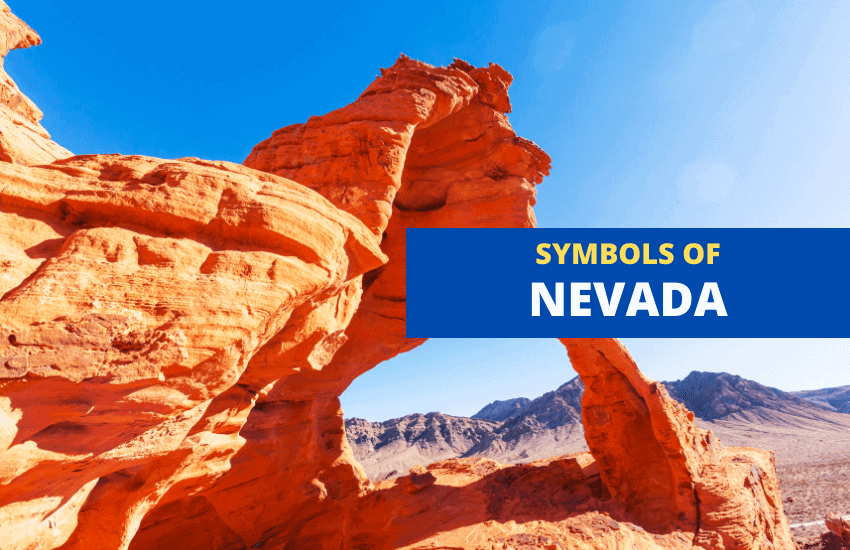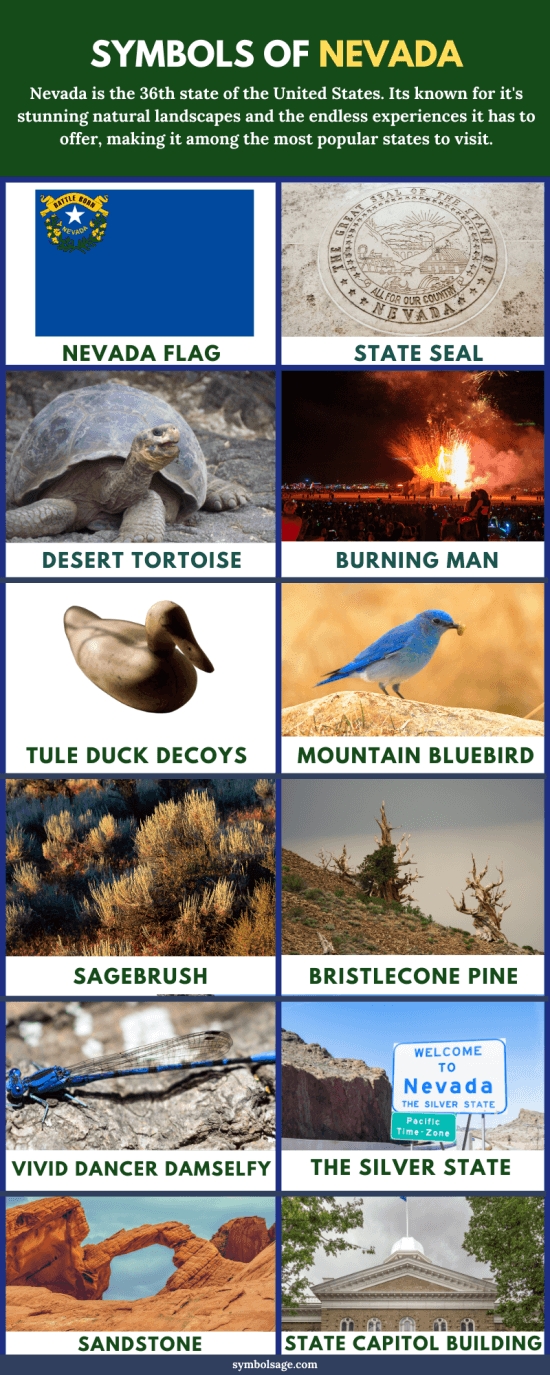
Table of Contents
Nevada, nicknamed the Silver State, is the 36th state of the United States, located in the western part of the country. The state is full of attractions and natural landmarks, including the Mojave Desert, Hoover Dam, Lake Tahoe, and its famous gambling capital Las Vegas. It also hosts Burning Man, a popular event held each year.
Nevada is known for its dry landscape and arid climate and the endless experiences it has to offer, making it among the most popular states to visit. It’s represented by a range of official and unofficial symbols that signify its rich heritage and culture.
In this article, we’ll be describing some of the official Nevada state symbols and where they come from.

Flag of Nevada
The flag of Nevada is comprised of a cobalt blue field with a silver five-pointed star in the top left-hand corner. The state’s name is featured just below the star and above is a yellowish-gold scroll with ‘Battle Born’ written on it. Around the state name are two sprays of sagebrush with yellow flowers on them.
Created by Governor Sparks and Colonel Day in 1905, the flag symbolizes the state’s natural resources of silver and gold. The blue hue is the same as that of the national flag of the U.S., signifying perseverance, justice and vigilance.
Seal of Nevada
The Great Seal of Nevada was officially adopted in 1864 by the proclamation of President Abraham Lincoln. It depicts the mineral resources of Nevada with a miner and his men moving a load of ore from the mountain in the foreground. A quartz mill can be seen in front of another mountain, with a train in the background, symbolizing communication and transportation.
A sheaf of wheat, a plow and a sickle can be seen in the foreground, representing agriculture. The natural beauty of the state is symbolized by the sun rising over the snow-capped mountain peaks. The seal has the state motto: ‘All for Our Country’ on the inner circle. The 36 stars in the inner white circle represent Nevada’s position as the 36th state of the Union.
‘Home Means Nevada’
In 1932, a young Nevadan woman called Bertha Raffetto performed a song she had written on the front lawn of the Bowers Mansion for a Native Daughter’s picnic. It was called ‘Home Means Nevada’ and was embraced by the crowd who enjoyed it immensely.
The song became popular very quickly and to such an extent that it was adopted as the official state song of Nevada in the next legislative session in 1933. However, the Native Americans didn’t approve of the song as they felt the lyrics were biased. Later on it was revised and a third verse was added to the song.
Burning Man
The Burning Man is a nine-day event that first began in 1986 in north-western Nevada and since then it’s been held every year at a temporary city in the Black Rock Desert. The name of the event was derived from its culmination, the symbolic burning of a 40-foot tall, wooden figure called ‘The Man’ that takes place in the evening of the Saturday before Labor Day.
The event gradually gained popularity and attendance over the years and in 2019, roughly 78,850 people took part in it. Any form of creative expression is allowed to take place at the Burning Man festival including dances, lights, crazy costumes, music and art installation.
Tule Duck Decoy
Proclaimed the state artifact of Nevada in 1995, the Tule Duck Decoy was first created almost 2,000 years ago according to evidence found by archaeologists. The decoys were made by Native Americans who bound bundles of tule together (also known as bulrushes) and shaped them to look like canvasback ducks.
The ducks were used as hunting tools to lure birds within the reach of spears, nets, or bows and arrows. They remain a unique symbol closely associated with the state of Nevada. Today, Tule Duck Decoys are still being made and used by the Native hunters of the U.S.
Mountain Bluebird
The Mountain Bluebird (Sialia currucoides) is a small bird with black eyes and a light underbelly. The Mountain Bluebird is an omnivorous bird that lives about 6-10 years in the wild, eating spiders, flies, grasshoppers and other insects. They’re bright turquoise blue in color and very beautiful in appearance.
In 1967, the Mountain Bluebird was designated as the official state bird of Nevada. The spiritual meaning of the bird is happiness and joy and many people believe that its color brings peace, keeping away negative energy.
Sagebrush
Sagebrush, designated the state flower of Nevada in 1917, is a name for several woody, herbaceous species of plants native to North American west. The sagebrush plant grows up to 6 feet in height and has a pungent, strong fragrance that’s especially noticeable when it’s wet. Like the common sage, the flower of the sagebrush plant is strongly associated with the symbolism of wisdom and skill.
Sagebrush is a highly valuable plant to the Native Americans who use its leaves for medicine and its bark to weave mats. The plant is featured on the state flag of Nevada as well.
Engine No. 40
Engine No. 40 is a steam locomotive built by Baldwin Locomotive Works of Philadelphia, Pennsylvania in 1910. It was originally used as the main passenger locomotive for the Nevada Northern Railroad Company until its retirement in 1941.
Later in 1956, it was used again for the 50th Anniversary excursion of the railroad and once more in 1958 to pull a chater train for the Central Coast Railway Club.
The locomotive, now restored and fully operational, runs on the Nevada Northern Railway and was designated as the official locomotive of the state. It’s currently located in Easy Ely, Nevada.
Bristlecone Pine
Bristlecone pine is a term that covers three different species of the pine tree, all of which are incredibly resilient to bad soil and harsh weather. Although these trees have low reproductive rate, they’re typically a first-succession species, meaning that they tend to occupy new ground where other plants can’t grow.
These trees have waxy needles and shallow, branched roots. Their wood is extremely dense, resisting decay, even after the tree is dead. They’re used as firewood, fence posts or mine shaft timbers and the special thing about them is their ability to live for thousands of years.
The bristlecone pine was named the official tree of Nevada as requested by students from Ely in 1987.
Vivid Dancer Damselfly
The vivid dancer (Argia vivida) is a type of narrow-winged damselfly found in Central and North America. Officially adopted in 2009, it’s the official insect of Nevada, commonly found near ponds and springs all throughout the state.
The male vivid dancer damselfly has thin, clear wings and is a rich blue color whereas the females are mostly tan or tan and gray. They grow about 1.5-2 inches in length and often mistaken for dragonflies because of their similar body structures. However, both have their own distinct physical traits.
‘Silver State’
The U.S. state of Nevada is well-known for its nickname ‘The Silver State’ which dates back to the silver-rush in the mid-19th century. During that time, the amount of silver found in Nevada was such that it could be literally shoveled off.
The silver had formed on the desert surface for millions of years, looking like heavy, gray-colored crusts, polished by the wind and dust. A silver bed in Nevada was several meters wide and longer than a kilometer, worth roughly $28,000 in 1860’s dollars.
However, in a few decades, Nevada and its neighboring states were completed picked clean of all silver and there was absolutely nothing left behind.
Needless to say, silver is the state metal of Nevada.
Sandstone
Sandstone makes up some of the most spectacular scenery in Nevada, found in areas like the Red Rock Canyon Recreational Lands and the Valley of Fire State Park. Nevadan sandstone is about 180-190 million years old and is made of lithified sand dunes from the Jurassic period.
The State Capitol building of Nevada is made entirely out of sandstone and in 1987, sandstone was designated the official state rock by the efforts of the Gene Ward Elementary School (Las Vegas) students.
Lahontan Cutthroat Trout (Salmo clarki henshawi)
The Lahontan Cutthroat Trout is native to 14 out of the 17 Nevadan counties. The habitat of this fish ranges from alkaline lakes (where no other type of trout can live) to warm lowland streams and high mountain creeks. Cutthroats were classified as ‘threatened’ in 2008 due to biological and physical fragmentation. Since then, measures have been taken to conserve this protect this unique fish and the the number of Cutthroats lost per year is far less than it used to be.
Nevada State Capitol Building
The Nevada State Capitol building is located in the capital of the state, Carson City. The construction of the building took place during 1869 and 1871 and it’s now included in the National Register of Historic Places.
The original Capitol building was shaped like a cross with two wings on the sides and an octagonal dome. At the start, it was used as a rest stop for pioneers on their way to California but later all it became the meeting place for the Nevada Legislature and the Supreme Court. Today, the capital serves the Governor and houses many historical exhibits.
Desert Tortoise
Native to the Sonoran and Mojave Deserts in southwestern United States, the desert tortoise (Gopherus agassizii) lives in areas with extremely high ground temperatures, that can exceed 60oC/140oF due to their ability to burrow underground and escape from the heat. Their burrows create a subterranean environment which is beneficial to other mammals, birds, reptiles and invertebrates.
These reptiles are listed on the U.S. Endangered Species Act as threatened and are now being protected. The desert tortoise was named the official reptile of the state of Nevada in 1989.
Check out our related articles on other popular state symbols:
Symbols of New York
Symbols of California








